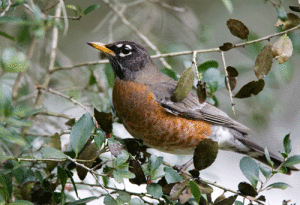
The American Robin is a spring harbinger for many, but here it’s a winter bird. By Mike Williams
Most folks have seen American Robins in the winter months along the mid and upper Texas coast, as they regularly erupt south for food when it gets scarce up north. They don’t as much “migrate” as many migrant species do… they erupt. A few species will tough it out up north as long as there is food. But in years when its hard to find forage they move, maybe south, east or west, or even north. Wherever the food is. They are a gregarious bunch, flocking to yards and feeders, town parks, or woodlands.
Robins are in the thrush “family” … and if we look at the original robins… well, they wouldn’t be robins at all! The American Robin was named after the European Robin, a much smaller and not closely related bird species from Europe, and certainly not a thrush. So how did the American bird get named a robin? Well, the European bird has a red breast, is often associated with Christmas holiday cards, etc., and when European settlers moved to North America they missed their little colorful bird and called what they found here, also with a red breast… a robin!
They also managed to physically bring with them House Sparrows (once called English Sparrow), Rock Pigeons, and European Starlings. Once those three species were released here they multiplied well, and are now found over much of the Americas! The settlers also named a few other birds here after the European birds they remembered. Buzzards, as Turkey Vultures were often referred as, got their names from Europeans. Although the Old-World buzzards aren’t vultures at all, but rather hawks! Oh well, small details! There are other examples as well, often confusing folks when traveling either way across the ocean.
Our robins here eat both invertebrates and fruit. In spring and summer, they can often be found pulling earthworms from moist lawns, and picking off insects, and even snails. They also eat a huge number and variety of fruits, berries, and many kinds of seeds, especially in winter when insects and invertebrates are scarce. They seem to feel at home in towns as well as in the countryside, and aren’t normally at all afraid to live alongside us humans. They are a fun bunch to watch as they hop around the grass at the Gulf Coast Bird Observatory, sometimes hovering over the ground looking for a bug, and even sitting motionless looking for a worm, a bit like a heron in water would for a fish.
Enjoy our holiday visitors… most years anyhow! They are certainly here this year!
